Lublin - Globocnik Austrian Connections
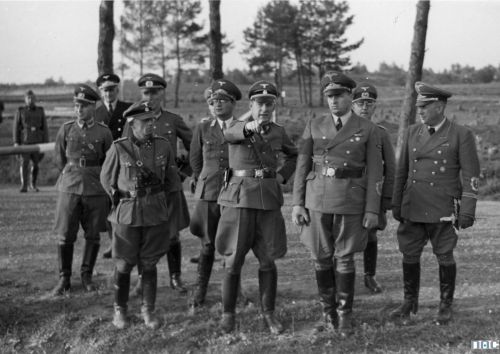
Odilo Globocnik next to Hans Frank at the border (NAC)
Odilo Globocnik the former Gauleiter of Vienna was appointed by RFSS Heinrich Himmler to the post of SS und Polizeifuhrer Lublin on November 9, 1939. From the onset of his activity in Lublin, Globocnik and his staff came up with radical measures, especially in relation to Jewish policy, forced labour and Germanization. Specific measures included the establishment of forced labour camps, the construction of fortifications on the Bug River, and at the border with the Soviet Union, brutal repression by the Lublin Selbschutz and the resettlement of the so-called Volksdeutsche, especially from Volhynia.
Globocnik struggled with the civilian administration of the Lublin district from the beginning, in particular on the issue of the 'Jewish matters'. ' As a former Gauleiter, however, Globocnik also laid claim to leadership in the district generally, in principle belonging to the civilian governor. Globocnik was appointed NSDAP district Standortfuhrer in May 1940.
Globocnik and his staff devised a convincing plan for the establishment of SS und Polizeistutzpunkte (SS and Police strong-points) in the Lublin District which met with Himmler's approval. Himmler appointed Globocnik as his commissioner for this task in November 1940. At the same time Globocnik established an SS- Mannschafthaus (SS Research Office) in Lublin, modeled after the ones in Germany university towns. The idea was to attract young SS academics to Lublin for serious planning for the strong-points and later the entire settlement and Germanization projects; he would thus, have at his disposal his own think tank. For the Germanization project, Globocnik relied not only his role as the authorized representative of the Reichskommissar fur die Festigung deutschen Volkstums (RKFdV) for the Lublin District - in conjunction with his position as SSPF: he also exercised sway over field offices of the Volksdeutsche Mittelstelle (VoMi) and the Rasse und Siedlungshampt in Lublin , all with close ties to the Forschungstelle fur Ostunterkunfe which had emerged from the SS-Manschafthaus in March 1942.
Following the June 22, 1941, attack on the Soviet Union, Himmler expanded Globocnik's brief for the establishment of strong-points within the entirety of the new 'Ostraum.' To this end, the Lublin Standort was to be expanded into a major SS base. Even though this order to Globocnik was revoked in March 1942, when it became clear that the technical specialists of the SS-WVHA were better equipped to develop the strong-points, the planning work of the SS Research Centre continued.
Einsatz Reinhardt, which Himmler had ordered Globocnik to execute, became the main project of the SSPF Office during 1942. Alongside the establishment of extermination camps, at Belzec, Sobibor and Treblinka, it included the exploitation of Jews in forced labour camps, the evacuation of the ghettos, deportations to the extermination camps and utilization of the belongings of the victims. Connected with the ghetto evacuations was the establishment in early 1943, of an economic complex based on Jewish forced labour, the so-called 'Ostindustrie GmbH in the Lublin District This project was closed down by Globocnik's successor Jakob Sporrenberg, after the mass executions of Aktion Erntefest in November 1943.
The first major Germanization project, was the clearance of the so-called Zamosc Lands, south of Lublin, which was carried out under Globocnik's stewardship starting in the autumn of 1942. This entailed the forced resettlement of more than 100,000 Polish residents. After it resulted in a massive growth of the resistance movement and other chaotic conditions - the project was abandoned in the summer of 1943. This failure contributed to Globocnik's next move. He was relieved of his duties in Lublin during September 1943, and he was promoted to Higher SS and Police Leader for the Adriatic Coast, based in Trieste, Italy.
To cover all its various functions, the SSPF in Lublin established an institutional web easily adaptable to multifarious requirements. A good general outline dates from August 1941, when the SSPF Office had to be restructured due to the work entailed by the SS and Police strong-points. Globocnik organized his offices into five main groups, each to work under its respective staff leader:
1. SSPF Office (Permanent Representative Chief of Staff SS-Obersturmbannfuhrer Nemec, for supervision and co-ordination of all SS agencies)
2. Office of the Representatives for the Establishment of SS and Police Strong-points in the New Eastern Territories (Permanent Representative SS Sturmbannfuhrer Maubach)
3. Volkspolitisches Referat to carry out all Germanization work in conjunction with the 4th main group (under Hauptgefolgschaftfuhrer Lothar von Seltmann)
4. Overall planning of the SS and Police Strong-points, cleansing of Jews, scientific mission within the scope of the SS-Mannschafthaus (under the auspices of SS-Obersturmfuhrer Hanelt)
5. NSDAP in the district (SS-Obersturmbannfuhrer Nemec)
The motor pool agency under SS-Sturmbannfuhrer Maubach was an independent unit. The order to carry out Aktion Reinhardt led to the creation of another department under Hermann Hofle, later named Hauptabteilung Einsatz Reinhardt. Concurrently, the office of the Representative for the Establishment of SS and Police Strong-points was dissolved.
Globocnik's multifarious tasks required more than the standard, rather modest staffing of an SSPF office. Unlike any other SSPF, Globocnik succeeded in having a large number of personnel assigned to him. These numbers can be seen from a chart dated October 27, 1943. According to the chart 153 people were ordinary members of the office of the Lublin SSPF; another 297 had been temporarily assigned to it for specific tasks: personnel for ethnic cleansing, from the racial and ethnic group institutions; personnel from the SS Deutsche Ausrustungswerke for the exploitation of forced labourers; and the aforementioned T4 personnel for the extermination camps. Not mentioned in Globocnik's list are the thousands of Trawniki guards. Also not mentioned are the young people brought in under the Osteinsatz or East Action under which members of the Hitler Youth and the League of German Girls were to help German resettlers replace Polish villagers expelled or deported. Many of the Osteinsatz youth came to the Lublin District to support Globocnik's Germanization projects, some of them female students from the Vienna University.
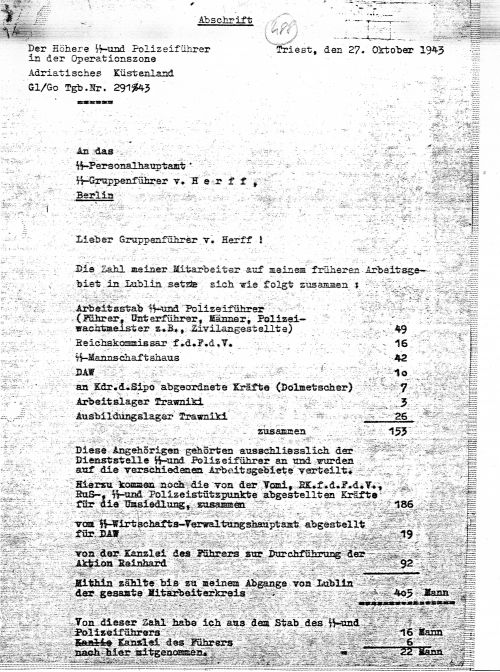
Globocnik - Von Herff - Chart showing staffing levels in Lublin (Yad Vashem Archives)
Globocnik's chart provides only a snapshot. It remains unclear to what extent it reflects fluctuations in staffing. Here we focus exclusively on the members of the SSPF Office With the exception of some members of staff in DAW concerns and Trawniki, most were stationed in Lublin itself. The Austrians in this group constitute our main focus. From this perspective of functions, the following four sub-groups are revognisable:
Core Staff and subordinates from the SS and Police, most without any professional qualifications. These included adjutants, chiefs of staff, personal aides, and orderlies. These worked in close contact with Globocnik and consequently had the most influence on the decisions and actions of the office.
Specialists such as historians, architects, agronomists, and builders, as well as racial and settlement experts, especially in the area of Germanization.
A group predominantly concerned with Jewish affairs, from basic Judenreferenten all the way up to the Aktion Reinhardt Office. Some of these were simply redeployment's within the SSPF Office.
Secretaries, drivers, interpreters, and the like, recruited for their professional skills. Formally, these had little influence over the SSPF Office, but they were in permanent contact with their superiors, co-operated very closely with the latter in secret actions, such as the murder of the Jews, and supported the actions of their superiors apparently without reservation. One should bear in mind that these staff members, especially the Austrian drivers, often had been political fellow travelers of their bosses for many years. The secretaries, in turn, often entered into private liaisons with male staff members or maintained social contacts with their wives and members of Globocnik's family.
The Core Group around the SSPF: Adjutants, Chiefs of Staff and Personal Aides
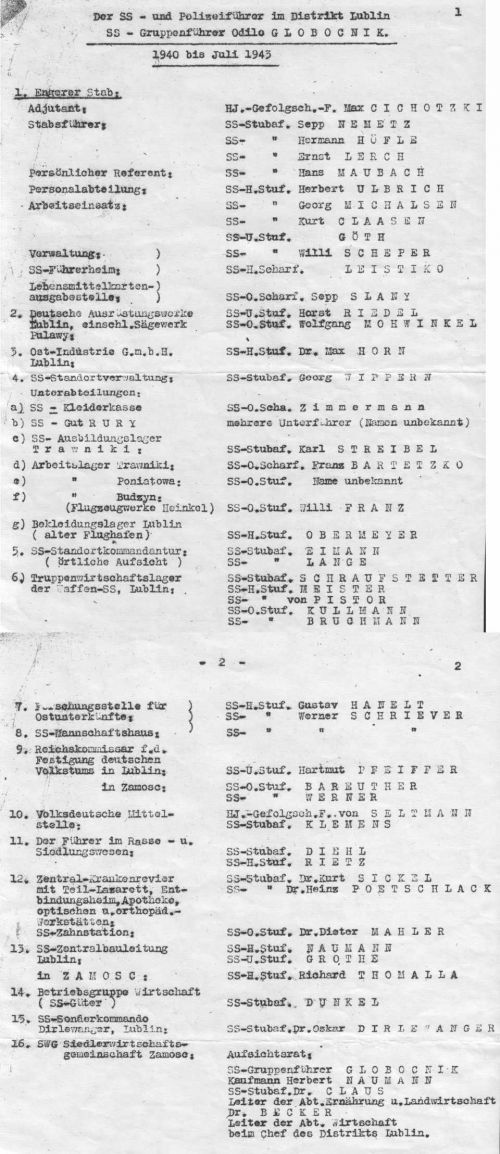
The function of adjutant was filled consecutively by two long-time comrades of Globocnik. Both came from Carinthia and had occupied important positions in the illegal Nazi movement or the SS before 1938. The first was SS-Hauptsturmfuhrer Reinhold von Mohrenschildt, born in 1915, at Leifling Castle near Unterdrauburg/ Dravograd, who later became a business graduate. His family had come from the Baltic. Mohrenschildt was active in the Hitler Youth even in middle school in Klagenfurt, where he and Globocnik were already friends.
When he entered the University for World Trade in Vienna in September 1933, he also secretly joined the SA, then banned in Austria, and later the SS. He acted for two years as a secret courier between the underground leadership of the Austrian Nazi Party and the Hilfswerk (relief organization) for the Gau of Carinthia.
Starting in 1935, he worked for the newly established SS intelligence service. In tandem with his university studies, Mohrenschildt completed a diplomatic training course at the Konsularakademie in Vienna in 1937. A few days before the Anschluss, Mohrenschildt was promoted to the position of adjutant to Hubert Klausner, the country leader of the Austrian Nazi Party. During those critical days during March 1938, he was in the midst of events with Klausner, Globocnik and the future Gauleiter Friedrich Rainer.
After Austria's unification with Germany, von Mohrenschildt became a 'policy expert' on the staff of the Deputy to the Fuhrer Rudolf Hess, and subsequently worked in the same capacity for Globocnik, when he was the Gauleiter of Vienna. During preparations for the invasion of Poland, he was ordered to join the Gauleiter in Danzig on August 15, 1939, for the execution of a special order by Ribbentrop.
When Globocnik was appointed SSPF Lublin on November 1, 1939, Mohrenschildt was appointed his adjutant In that capacity he worked on the resettlement of ethnic Germans from Volhynia, to the German -occupied portion of Poland that followed as part of the Molotov-Ribbentrop Pact - a transfer enabled by the expulsion of Polish villagers.
In July 1940, von Mohrenschildt went to work for the newly appointed Reichskommissar for the Netherlands, Arthur Seys -Inquart, as secretary for political issues. His position in the Netherlands seems to have turned sour rather quickly, because he relocated to Berlin that September. There he married Margarete Kaufmann, sister-in-law of Ludolf Jakob von Alvenslaben, leader of the Lublin Selbtschutz.
Reinhold von Mohrenschildt returned to Lublin in October 1941. Since the position of adjutant had in the meantime been taken by Ernst Lerch, he was appointed RKFdV commissioner. Mohrenschildt's blatant attempt to enhance his credentials in the Netherlands had not been appreciated by everyone. The HSSPF Ost Wilhelm Kruger, for instance, refused a recommendation of promotion for von Mohrenschildt submitted by Globocnik in February 1942, because von Mohrenschildt is a so-called political migratory bird.
But in the autumn of 1942, Globocnik gave von Mohrenschildt a leading role as RKFdV representative in the Zamosc Lands Germanization project. When Odilo Globocnik was assigned to Trieste in September 1943, von Mohrenschildt was one of the sixteen members of the SSPF Office, he asked to bring with him.
Reinhold von Mohrenschildt successor as Globocnik's adjutant was Ernst Lerch, born in Klagenfurt in 1914. Lerch completed a hotel management course in Vienna in 1931, and worked as a waiter in Swiss and French hotels afterwards. When he returned to Austria at the end of 1934, he was already a member of the Nazi Party and the SS.
Officially Ernst Lerch worked in his parents cafe in Klagenfurt; actually he was working in the illegal SS intelligence service essentially set up by Globocnik, and later in the SD sub-section of Carinthia, whose directorship he assumed in February 1936. According to his own statement, Lerch was in charge of approximately eighty clandestine associates. This network was to become a main recruiting ground for the staff of the SSPF Office in Lublin.
After March 1938, Lerch was entrusted with the full-time directorship of the SD section of Klagenfurt. His close relationship with Globocnik, who by now had risen to the post of Gauleiter of Vienna, is evident from the fact that Globocnik in conjunction with Helmut Ortwin Pohl, acted as Lerch's best man when he married Gertrude Fercher from Klagenfurt in August 1938. Lerch was to meet Helmut Pohl again in Lublin a little later.
In September 1938, Lerch underwent training at the SD school in Bernau; after this he was drafted into the Wehrmacht and took part in the invasion of Poland. For the benefit of the SD in Carinthia, however, he was exempted from military service as of February 1, 1940, to work for the Regional Borderlands Office, resettling ethnic Germans from the South Tyrol and Val Canale in Italy to the Klagenfurt area in Austria.
With the move to Lublin in July 1940, Lerch became Globocnik's closest and most important collaborator in the SSPF Office. He assumed the position of Chief of Staff in March 1942, after Josef (Sepp) Nemec left Lublin. Lerch's successor as adjutant was Max von Czichotzki, a senior Hitler Youth official from the ranks of the German-speaking minority in Poland. Von Czichotzki, who did not belong to the core group around Globocnik and probably got the job owing to a lack of alternative candidates, was never able to wield the same influence inside the SSPF Office as Lerch had. Globocnik's one-time fiancee and secretary Irmgard Rickheim characterized Czichotzki, as the 'little adjutant,' junior to Lerch. According to Georg Michalsen, he played 'something midway between an adjutant and an orderly. Later on as Globocnik's adjutant he went to Trieste along with Globocnik.
Like the first two adjutants, the two Chiefs of Staff were also long-standing comrades with Globocnik. The trained mechanical engineer and builder Paul Gasser had been a close friend of Globocnik since the 1920's. Both men were veterans of the Nazi movement in Carinthia. Actively involved in the attempted coup by the Nazis in the Lavanttal in Carinthia in July 1934, Gasser fled to Yugoslavia, clandestinely returning not long afterward and working in the underground until 1938.
After March 1938, Gasser became Globocnik's personal aide and adjutant when Globocnik became Gauleiter of Vienna. Even after Globocnik was relieved of his post, Gasser remained among those in the close circle around him. He completed his SS military training with Globocnik, and later they both switched to Lublin. The SSPF Office was established during his time there. But in the summer of 1940, he volunteered for duty on the front, possibly as a result of a fallout with Globocnik.
Gasser's successor, was the Viennese Josef (Sepp) Nemec, who belonged to the small circle around Globocnik in the underground as well as during Globocnik's term as Gauleiter of Vienna. Nemec was born during 1901. He was a Viennese furniture company clerk. Nemec occupied a key position in the illegal Nazi movement in Austria. Joining the Nazi Party in 1932, and the SS in 1935, he served as financial manager and adjutant to the SA-Obergruppe Ostereich, and as head of the illegal Austrian Hilfswerk of the Nazi Party after 1936. After the Anschluss, Nemec worked under Globocnik as an SD-Fuhrer and one of three Gau inspectors in Vienna.
In appreciation of Nemec's service Globocnik arranged for him to be awarded the highest decoration of the Nazi Party, the Golden Party Badge, on January 30, 1939. Sepp Nemec acted as Globocnik's Chief of Staff in Lublin from August 1940, to March 1942. Like Gasser, he resigned following a personal conflict with Globocnik, though the details remain unknown.
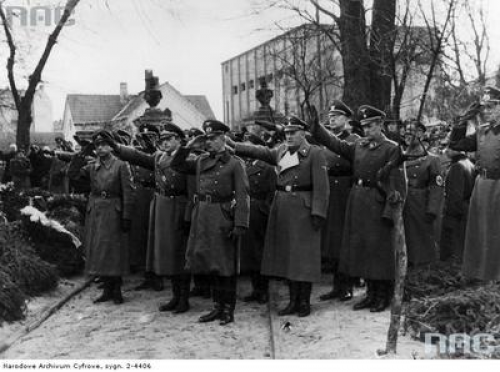
Lublin Lipowa Street Cemetery - Sepp Nemec stands next to Globocnik saluting (NAC)
Officially, the position of Chief of Staff was not filled again. Ernst Lerch took over Nemec's duties. Suspicious of traditional bureaucracies and determined to prevent the evolution of fixed organizational structures in the SSPF offices, Himmler decreed in late 1941, that henceforth only 'heads of personal office' should be appointed, rather than the more formal -sounding Chiefs of Staff. Lerch was therefore merely Globocnik's 'head of personal office.' Nevertheless Lerch probably enjoyed more influence than Nemec had before him, given that Czichotzki had not made the position strong and that Maubach had left.
Higher-ranking SS Officers criticized Lerch's influence, although their dissatisfaction was expressed in such a way as not to undermine the authority of the SSPF. For instance the chief of the SS-Personalhauptamt, Maximilan von Herff, strongly criticized Lerch during May 1943, during a moment of fierce conflict over Globocnik's Zamosc Lands Germanization project. Nonetheless von Herff's blunt criticism of Lerch had no effect. Globocnik fiercely protected Lerch and later took him along with most of the inner circle to Trieste.
Alongside his adjutant, the SSPF was initially assisted by his personal aide Hans-Gustav Maubach. He was born in 1904, near Bonn. Maubach did not hail from Globocnik's narrow circle, but did come to Lublin through the mediation of one of Globocnik's close political comrades-in-arms, Gauleiter Friedrich Rainer. Maubach had most recently been a senior Hitler Youth official, and before that worked as an expert in foreign minister Ribbentrop's office, where he oversaw youth matters. According to Maubach himself, Rainer believed Maubach could mitigate tensions between Globocnik and the civilian administration, and initially got him assigned to the civilian administration as an expert on personal matters.
And yet there seems to have been no such conflict at the end of 1939, or at the beginning of 1940, when Maubach arrived in Lublin. It is possible that the decision was merely about having a person of trust in the civilian administration: at a meeting in Berlin just before Maubach's transfer. Globocnik speculated about taking on the position of the civilian Governor there himself. And in the early summer, Maubach switched to the SSPF Office.
As a personal aide, Maubach took on varying extra duties such as overseeing the motor pool, supervising the forced labour camps of the DAW in Lublin and representing Globocnik in the establishment of the SS and Police strong-points. After conflicts with the Austrian core group, however, Maubach left Lublin in January 1942. Maubach himself stated after the war that the Carinthian and Viennese clique around Globocnik - particularly Nemec and Lerch - had interfered so much with his work as personal aide that he and Globocnik had become estranged.
The probable cause for the break with Globocnik was an arcane affair in which Globocnik shifted the blame to Maubach for problems in provisioning Heydrich's staff in Prague. Another source of possible conflict, about which Maubach complained fiercely, was the rumour among the staff that his wife was Jewish, His position was left vacant, and his responsibilities probably were divided between Lerch and Czichotzki.
Unlike his personal aide, Globocnik's orderly was a long-standing confidant from Carinthia. SS-Rottenfuhrer Rudolf Schleissner, who was a waiter by profession and who worked at the Cafe Lerch from 1927. Cafe Lerch was an extreme nationalist stronghold and information hub of the illegal Nazi Party in Austria, for which Schleissner worked starting in 1933. After joining the illegal SS in 1935, he was active for the Carinthian SD, headed by Ernst Lerch.
Already prior to the Anschluss, Schleissner had been engaged to Luise D. from Carinthia, who also had worked at Cafe Lerch as a chef since 1927, and was also working for the illegal Nazi Party after 1933. Following the Anschluss - and apparently owing to their excellent Nazi Party contacts - the couple were able to lease a beach hotel on the southern bank of the Worthersee. During the 1943, transfer from Lublin, Globocnik and his retinue gathered there before continuing on to Trieste.
Earlier in Lublin, Schleissner had taken over the management of the Deutsches Haus, which was situated in the centre of the city, alongside a restaurant and cafe, this establishment also housed a casino reserved for officials only. Schleissner also worked as the chef and manager of the restaurant. Thus, as facilitator of informal exchanges of information, Schleissner carried forward in Lublin the same position he had occupied in the Cafe Lerch in Klagenfurt.
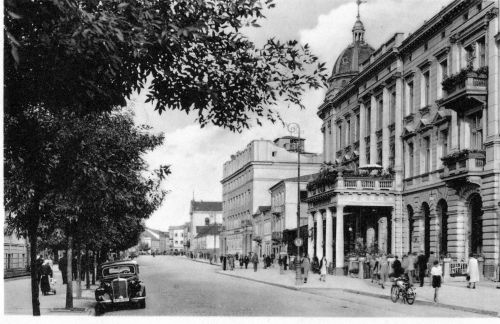
Lublin - Deutches Haus (Chris Webb Private Archive)
The departments for administration and personnel were not manned by Austrians. The competent personnel expert was SS-Hauptsturmfuhrer Herbert Ulbrich from Breslau, who served previously as the adjutant to SSPF Friedrich Katzmann in the Radom District. Wilhelm Scheper, from Lower Saxony, had previously had worked for the administrative department of the Sachsenhausen Concentration Camp, in Lublin, was put in charge of administration.
Globocnik's efforts to establish in Lublin, an SS-Mannschafthaus like the ones in many German university towns started as early as in the autumn of 1940. From the outset Globocnik pursued his objective of establishing his own institute for Germanization to be independent of other research on Eastern European offices. To that end, he turned to Kurt Ellersiek, commander of the Mannschafthauser and chief of the Racial Office of the RuSHA in Berlin, and initiated the transfer of two associates, Gustav Hanelt and Claus Walter Padel. For the first time, Globocnik recruited personnel from 'outside' institutions whose chiefs wanted 'branches' in Lublin.
SS-Hauptsturmfuhrer Gustav Hanelt was born during 1914, in Schmachthagen, Holstein, the son of a master brickmaker. He joined the Nazi movement while still attending school, and joined the SS in 1933: as early as 1935, he was working as a clerk in the RuSHA. Funded by the Reich Student Union, Hanelt studied history and anthropology in Berlin: he completed his military service in October 1937. The RuSHA sent him to Konigsberg to establish and manage a Mannschafthaus.
In the middle of 1938, Ellersieck brought Hanelt to be his associate in the Berlin headquarters; simultaneously Hanelt studied law at the Hamburg University. After brief service in the Wehrmacht, he arrived in Lublin in October 1940, to organize the Mannschafthaus there. From then on he played a vital role in the SSPF Office. Planning for SS and Police Strongpoints - prior to that, limited to the Lublin District - grew enormously with the June 1941, invasion of the Soviet Union, and was centralized under Hanelt's supervision. Hanelt also belonged to the group that accompanied Globocnik to Trieste in 1943.
Hanelt sought out young SS college graduates for the Lublin Mannschafthaus. In March 1942, his staff included six such graduates, eight police sergeants, and three Polish construction technicians. Again, a number of Austrians were recruited, especially for the senior positions, although professional expertise dictated the hiring of more non-Austrians. Franz Stanglica, a historian, born in Vienna during 1907, was hired in 1941, as director of the Research Centre, and the person responsible for the Planning, Research, and Statistics Main Department. Stanglica received his doctoral degree at Vienna University in 1931, after working under the German nationalist historian Heinrich Ritter von Srbik.
Stanglica moved among the circle of the extreme German -nationalist historians engaged in writing the compendium of Germandom in the border regions and abroad, 1933 -1938. As provisional registrar in the Court Chamber Archives, Stanglica was also fully involved in a clandestine project of the Reich Institute for the History of the New Germany, in Munich, which had commissioned a study on the role of the Jews in the Austrian economy between 1750 and 1825.
After the Anschluss he joined the Nazi Party, enlisted during October 1940, in the Waffen-SS, and soon was deployed to the guard service at the Auschwitz Concentration Camp. His transfer to Lublin, probably took place in early 1941. All early planning for the principal Germanization projects in the district, including the Zamosc Lands resettlement, took place under his aegis.
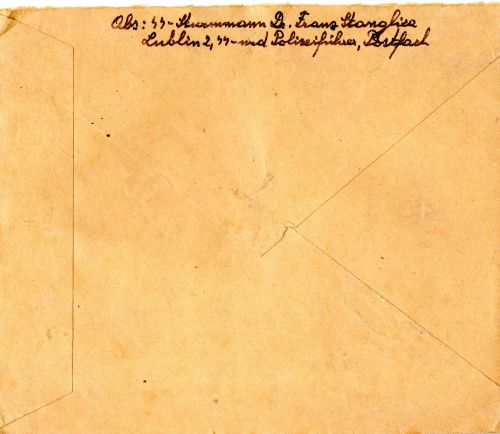
Dr. Franz Stanglicka personal correspondence to Vienna November 1942 (Chris Webb Private Archive)
The architectural department was headed by Jurgen Lassmann from Vienna, who had already been active in the Vienna SS-Mannschafthaus. Lassmann was born during 1914, to a teacher's family. He studied at the Vienna University of Technology. Beginning in 1933, he was active in the illegal Nazi movement, and in 1934, was barred from the University for one year. Among other things Lassmann clandestinely recruited architects into the banned National Socialist German Students Union for Austria; he was simultaneously occasional leader of the official Hochschulerschaft at the University of Technology. A member of the illegal SS since 1937, Lassmann was ordered after the Anschluss to recruit personnel for an SS-Mannschafthaus in Vienna. Upon graduation, he worked for the German Settlement Society. Lassmann was drafted into the Waffen-SS during mid-1940, but was wounded. He was transferred to the Research Centre in Lublin, in early 1942. Both Lassmann and Stanglica, like Hanelt served later with Globocnik, in Trieste.
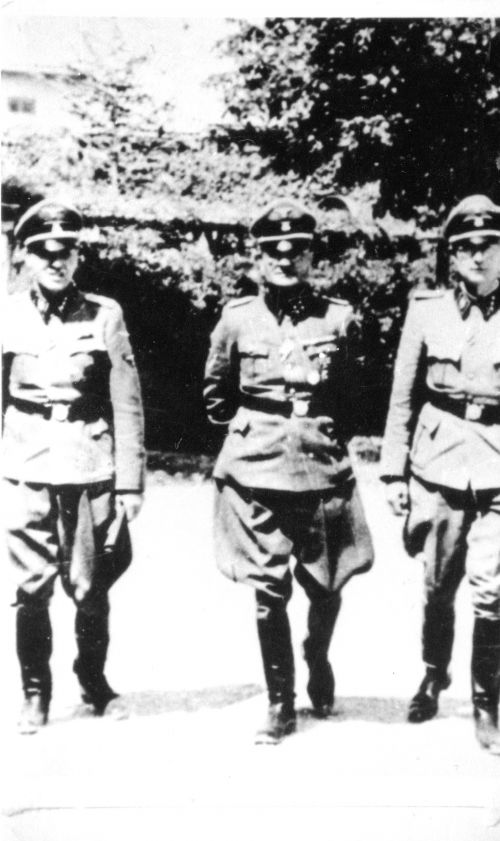
Schwarzenbacher, Wirth and Lassmann (Holocaust Historical Society)
The outposts of two of the three institutions most crucial for Globocnik's programmes in Lublin - the RKFdV, VoMi which was housed in the SS-Mannschafthaus and RuSHA were run by Austrians. the RKFdV VoMi office came under Globocnik's first adjutant, Reinhold von Mohrenschildt; the VoMi came under Lothar von Seltmann from Graz, and later on under Ernst Lerch. The RuSHA ofice established in October 1941, was headed by the German Heinrich Thole.
Lothar von Seltmann was born during 1917, in Graz, to a secretary at the Imperial Governor's office. As a teen he was a Nazi Party millitant. He joined the NS Schulerbund in 1931, and the SA in 1933. He was forced to change schools after he came under suspicion for involvement in a number of bombings that students and teachers carried out against the Traiskirchner Bundeserziehungsanstalt - Federal Reformatory in the spring of 1933. One year later, he was arrested for selling a banned Nazi newspaper. Seltmann fled to Germany and joined the 'Austrian Legion.' He returned to Vienna in August 1938, and took on the directorship of the Popular Union for Germandom Abroad.
After the Second World War began, Seltmann served briefly in the Waffen-SS, but was then transferred to the Volhynia resettlement for the VoMi. During 1940, Seltmann was appointed VoMi Commissioner in Lublin, where he became involved in resettlement operations in the regions of Chelm and Lublin. In the summer of 1941, he was officially assigned to head the Main Department 'Volkspolitsches Referat' (desk for racial and ethnic policy) in the SSPF Office, responsible for assisting German resettlers.
With the assumption of additional responsibilities, initially for the Galizien Distrikt and later for the entire Generalgouvernement, Seltmann left the SSPF Office in Lublin in February 1942, and switched to the HSSPF Ost in Krakau. In June 1942, he joined the staff of the SSPF of Krakau Distrikt. He was transferred to the Eastern Front in 1943. Seltmann was later reported missing in action near Murmansk.
Himmler's order to establish the SS and Police Strongpoints in the Lublin District in November 1940, was closely connected to the creation of the SS Mannschafthaus and various Germanization institutions. Hence, Hanelt, and Padel, brought to Lublin for work on the SS Mannschafthaus in October 1940, also had to deal with the establishment of the SS and Police Strongpoints - at least initially.
Following Himmler's order to extend the SS and Police Strongpoints to all the occupied Soviet Territories, Globocnik appointed Maubach to head a new office. of the Representative for the Establishment of SS and Police Strongpoints in the New Eastern Territories; Globocnik appointed the deputy commander of the police regiment in Lublin, Hermann Kintrup, chief of staff of the new office.
Kintrup, however, left that posting at the end of 1941, or at the beginging of 1942, after his promotion to commander of the Order Police in Lublin. While the entire planning of the strongpoints was incumbent on the SS Mannschafthaus, the new department was to ensure their practical implementation. The three field offices that Globocnik set up for the establishment of the strongpoints were headed by non-Austrians. All three had experience with the exercise of violence prior to serving in Lublin, such as service in the Volksdeutsche Selbstschutz.
Riga for the North Russia region was headed by SS-Hauptsturmfuhrer Georg Michalsen, who came from Oppeln, in Upper Silesia. Mogilew - later Minsk for the Central Russia region by SS-Obersturmfuhrer Kurt Claasen, originally from Schleswig-Holstein, and Kiev for the South Russia region by the construction engineer SS-Obersturmfuhrer Richard Thomalla, who hailed from Sabine-bei-Annahof, in Upper Silesia. .
Shortages of personnel and materials as well as conflicts with the SS-Hauptamt Haushalt und Bauten (Budget and Building Main Office), on whom Globocnik depended for the construction of his buildings, prevented the strongpoints construction projects in the Soviet territories from ever going beyond the prepatory stage. After Maubach's departure, Hermann Hofle, charged after September 1941, with economic operations, assumed the main responsibility for the office for a while.
Following Himmler's order to renove Globocnik, however, the office was dissolved at the end of March 1942. Himmler justified Globocnik's removal by the fact that the organization of the occupied territories had proceeded to a new stage. In reality Globocnik and his staff were separated from the SS and Police strongpoints for other reasons. These were due to incompetence, logistical difficulties, the impact of the Soviet milltary offensive before Moscow during the winter of 1941 -1942. And more significantly the diversion of available resource for the implementation of Aktion Reinhardt, which was the murder of Polish Jewry as part of the Final Solution to the Jewish problem.
Prominent staff protagonists of genocide undoubtedly included the so-called Judenreferenten, all of whom were from Austria. As early as December 1939, Globocnik had established the first Judenreferat, setting off a sustained conflict with the Gouveneur Ernst Otto Emil Zorner - these desks had not originally been planned for the SSPF, so this was in fact a usurpation pf a preserve of the civilian administration.
At a time when Lublin was still considered a 'Jewish Reservation' and the Volhynia resettlement was being carried out, Globocnik appointed legal scholar and international law expert SS-Untersturmfuhrer Karl Hofbauer as Judenreferent. Hofbauer originally came from Villach in Carinthia. His education distinguished him among the other SS leaders, one of the reasons that Globocnik took him to Lublin in December 1939.
At the time Globocnik made him Judenreferent.he had been an assistant at Vienna University Institute of Statistics for Minority Peoples, and had completed, a number of research visits to Western Europe. From 1937, to the end of 1939, he had been prefect of law at the Consular Academy in Vienna, where he lectured on international law. A member of the Nazi Party since 1930, and of the SS since 1931. Hofbauer also had worked for the SD during his time at the Academy.
Hofbauer stayed in Lublin just over six months. On August 6, 1940, he took part in a meeting on the deployment of Jews for forced labour, which was held in the headquaters of the Generalgouverneur in Krakau. Shortly afterward he was sent to Semlin in Yugoslavia to facilitate the resettlement to occupied Poland of ethnic Germans from Bessarabia after the Molotov - Ribbentrop Pact transferred that province from Romania to the Soviet Union, and the refugees journeyed via Yugoslavia. Hofbauer did not return to Lublin, likely out of frustration at his loss of control over 'Jewish matters' to the civilian administration.
After Hofbauer's departure, Ernst Lerch, just appointed Globocnik's adjutant, was additionally assigned the position of Judenreferent, reflecting the crucial role he already played as Globocnik's de facto deputy. But the conflict between the civilian administration and the SSPF Office that had flared up under Hofbauer continued under Lerch.
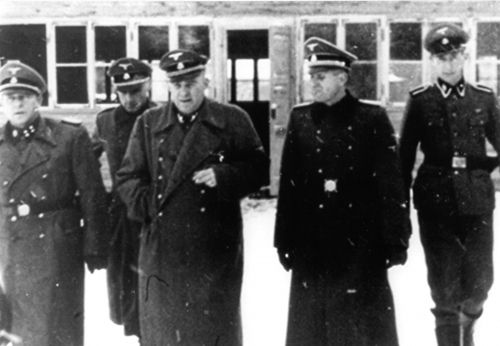
Hofle front row next to Globocnik (USHMM)
The multitude of tasks entailed in Aktion Reinhardt - running labour camps, the construction of the extermination camps, the evacuation of ghettos, the arrangement of deportation trains, the utilisation of murdered people's belongings - could not be handled by a mere 'desk' as it was under Hofbauer and Lerch. Globocnik accordingly created within his staff a new Main Department, headed from March 1942, by Hermann Julius Hofle. Previously Hofle had been an automobile mechanic and former owner of a taxi firm, born in Salzburg during 1911.
Hofle had helped to set up illegal Nazi Party and SS organisational structures in Austria beginging in 1933, and had served time in prison for these activities. After the Anschluss, he assumed a full-time role as leader of Sturmbann 1/76, from which Gauleiter Rainer recruited some personnel for the Gauleitung staff. For a short time Hofle attended the SS-Fuhrerschule in Dachau, and was deployed as provisional leader of the 76th SS-Standarte from the beginging of the war until December 1939.
Hofle was area leader in the Volksdeutsche Selbstschutz, an organisation that terrorised and murdered members of the Polish elite and the Jewish minority in the Neu-Sandez District from December 1939, well into 1940. After the dissolution of the Selbstschutz, Hofle was transferred to Globocnik in Lublin during the autumn of 1940. Initially, Hofle was deployed as commander of one of the forced labour camps for Jews during construction of the Bug River fortifications, the largest forced labour project in the Lublin district. Afterwards he served as SSPF deputy chief of staff in Lublin, responsible for the establishment of the SS and Police strongpoints.
A few weeks before the evacuation of the Lublin ghetto, Hofle was appointed head of Globocnik's Aktion Reinhardt Main Department located in the Julius Schreck Kaserne, at Litauer Strasse 11. There is a school of thought that suggests that there had been no earlier preparations for staffing Aktion Reinhardt, and Hofle himself had been scheduled at the end of 1941, or early 1942, to head a planned SS and Police Strongpoints base in Tbilisi, Georgia. The stagnation of the German advance, however, rendered that plan obsolete. Instead charged with the Aktion Reinhardt role, Hofle brought those of his associates who had proven most reliable in their work on the SS und Polizei strongpoints; among those were his deputy Helmut Ortwin Pohl from Klagenfurt, as well as the previously mentioned Richard Thomalla, Georg Michalsen, and Kurt Claasen. His department was strengthened by Amon Leopold Goth, from Vienna and the Carinthian Albert Susitti in the spring of 1942. Hofle thus occupied one of the key positions, in Aktion Reinhardt, and bore the responsibility for the murders of untold number of Jews on his conscience.
The mass deportations of the Jews from the Lublin ghetto took place under Hofle's direction begininging in March 1942, to the extermination camp in Belzec, and these were followed by the mass deportations from the Warsaw ghetto in July 1942, to the Treblinka extermination camp. Not much is known about the personal relationship between Hofle and Globocnik, but it should be noted that this officer from Salzburg, Hofle did not initially join Globocnik in Trieste. He remained in Lublin, as the personal office head for Globocnik's successor, SS-Gruppenfuhrer Jakob Sporrenberg. In this position he directed Aktion Erntefest (Harvest Festival) on November 3 -4, 1943. This Aktion saw the mass shooting of more than 40,000 Jewish forced labourers in a number of camps within Lublin itself and from Jewish camps in Poniatowa and Trawniki.
Hofle's deputy and friend - and best man at Lerch's wedding - Helmut Ortwin Pohl, was typical of the other Carinthian SS-men in Lublin. He was born in 1901, in Klagenfurt, a member of the Nazi Party and SS since 1930, active in the underground, experienced several arrests , worked for the SD sub-section for Carinthia. From the autumn of 1939, he was a member of the SS-Totenkopfverband in Krakau and Posen, and participated in various expulsions and resettlements.
From the autumn of 1940, he was again working in his civilian occupation as an Accountant and Head of Department in a Leather Factory, but a few weeks prior to the commencement of Aktion Reinhardt, he was sent to Lublin, to work under Hofle in the establishment of the SS und Polizei Strongpoints programme. Following Hofle's as Judenreferent, Pohl took over the responsibilty for the Strongpoints. Afterwards, he worked as Hofle's deputy in the Aktion Reinhardt Main Department. Among other things, Pohl was responsible for the daily transports of Jews arriving in Lublin, the selection of workers from among them, and the transfer of the remainder to the extermination camps. Pohl left the office once more in June 1942, and returned to his civilian profession in Klagenfurt, where he remained until 1944. He was obviously valued there, as Globocnik's attempts to bring him to Trieste failed, due to Pohl's exemption from military service.
SS-Untersturmfuhrer Amon Leopold Goth, was born in December 1908, in Vienna. Goth joined Hofle's Aktion Reinhardt Office in 1942, and was responsible for a number of ghetto clearences, such as Zamosc. However, he fell out with Hofle, and was transferred to Krakau, where he commanded the Plaszow Jewish Labour camp, which later became a concentration camp, from February 1943, to September 1944.
SS-Unterscharfuhrer Albert Susitti also joined Hofle. Born in Maria Rain near Klagenfurt in 1910. He also came directly from Globocnik's Carinthian environment. As a manager in a Klagenfurt sports store, he had been an activist in the Nazi movement since 1929. In conjunction with future Gauleiter Rainer, he founded a 'club' that fronted for the organisation of the Nazi underground. After Susitti joined the SS in March 1938, Rainer created a position for him as Gau warden for track and field, while Susitti simultaneously served as an expert on sport in the 90th SS-Standarte. Susitti was drafted in late 1939, but Globocnik managed to have him transferred from a Waffen-SS regiment to Lublin, again as an expert on sport. Susitti later joined Globocnik in Trieste.
Two other departments were directly involved in Aktion Reinhardt, Der Inspekteur der SS -Sonderkommando's, employing former T4 personnel under Christian Wirth, the former commandant of the Belzec extermination camp, and Department IVa Aktion Reinhardt, which registered and utilized the belongings of their victims, and oversaw the transfer of valuables to the Reichsbank. In the spring of 1942, the SS-WVHA assimiliated IVa under the SS-Standortverwaltung in Lublin, headed by SS-Sturmbannfuhrer Georg Wippern.
In order to facilitate the transfer of the murdered Jews, Wippern employed trained bank personnel. Jewish forced labourers were assigned to the actual sorting, located at Chopin Strasse, and at the sorting hangers located at the Alter Flugplatz, just outside Lublin. Among the banking experts assigned to Wippern, was Alois Rzepa, born during 1908, in Schrems, Lower Austria. It is not known whether Globocnik was directly involved in his recruitment. Rzepa not only had been a clerk of the Landerbank in Vienna, but he had also been an SS member with experience of the pre -1938, Nazi underground.
The drivers of the SSPF Office worked in particularly close contact with their superiors. By the very nature of its responsibilities the SSPF Office was characterised by great mobility, essential for efficiently enforcing German control with limited personnel. Globocnik's personal aide Maubach was responsible for the motor pool up to the end of 1941. Following a brief gap, SS Untersturmfuhrer Max Meierhofer from Salzburg, took over in the summer of 1942. Meierhofer was born during 1909, in Mattsee. Meierhofer had been responsible for the motor pool under HSSPF Alfred Rodenbucher in Salzburg, starting in 1939. It is likely that a connection to Hofle there led to Meierhofer's transfer in May 1942, to Lublin. In Lublin he was viewed as Hofle's friend and served as his driver at times.
After a short time administering Department IVa, Aktion Reinhardt' s warehouse for clothing and other property taken from the Jews, who were murdered in the death camps, Meierhofer participated actively in the mass deportation aktions conducted in the Warsaw Ghetto. An ardent amateur photographer, he photographed an old woman in a wheelchair, then shot her. He sent two photographs as souvenirs to a friend, one showing the woman in the wheelchair, the other of her on the ground after he had thrown her out of it. Meierhofer later also accompanied Globocnik to Trieste.
Thirty to forty drivers worked for the motor pool, among them a number of Ukrainians. Six of the fifteen German-speaking drivers came from Austria, where each had belonged to Globocnik's political or official circle. In Lublin they became the personal drivers of the principal members of his staff. Most of the drivers from Germany, on the other hand, came from the police. All of Globocnik's personal drivers - Leopold Veith, Franz Bertl, Franz Eigner, and Benedikt Farkas - hailed from Vienna or Lower Austria. Eigner had been Globocnik's second driver in Vienna - as Gauleiter he was entitled to two, in the winter of 1938-1939. Several of the Austrian drivers accompanied Globocnik to Trieste.
There were a total of fifteen female typists who worked in Globocnik's SSPF Office, five of these hailed from Austria. Rosalie B. an employee of Gauinspektor Josef Nemec since 1938, arrived in Lublin together with her boss in the summer of 1940. Berta Gottschall, from Salzburg, Leader in the League of German Girls in 1939, was assigned to Poland under the Osteinsatz. She got to Lublin through the regional Party network and her contact with Hermann Hofle. She served as Hofle's personal secretary during the deportations from the Warsaw Ghetto. Margarete S. also from Vienna, gained promotion to Lublin through her personal acquaintance with Reinhold von Mohrenschildt's sister.
The Viennese book-keeper Wilhelmine Trsek, who had worked part-time for the Nazi Party, was recruited in Vienna for Lublin. In Lublin she was Globocnik's personal private secretary. The secretarial pool also included wives of SSPF staff members or of officials of other offices in Lublin. Also working in Lublin as a secretary was Globocnik's one time fiancee Irmgard Rickheim, who owned her position to Hans-Gustav Maubach.
Sources
Bertrand Perz, The Austrian Connection: SS and Police Leader Odilo Globocnik and His Staff in the Lublin District. Holocaust and Genocide Studies 29, no.3 Winter 2015
Joseph Poprzeczny, Hitler's Man In The East Odilo Globocnik, McFarland & Company Inc Jefferson North Carolina 2004
Chris Webb, The Belzec Death Camp, ibidem-verlag, Stuttgart 2016
Photographs: NAC, Chris Webb Private Archive, Holocaust Historical Society , USHMM
Documents: Yad Vashem Archives, National Archives Kew
Envelope: Chris Webb Private Archive
© Holocaust Historical Society December 18, 2021

